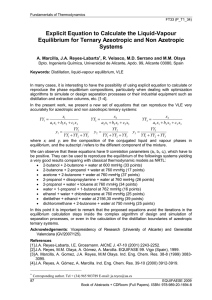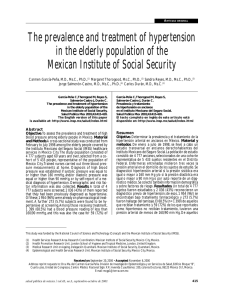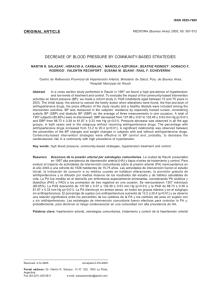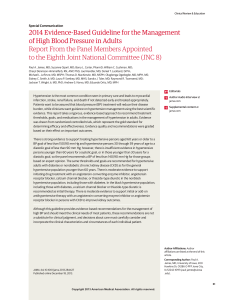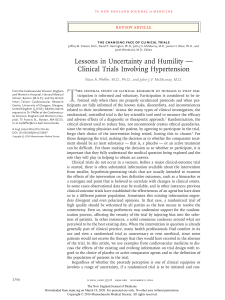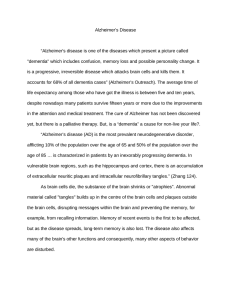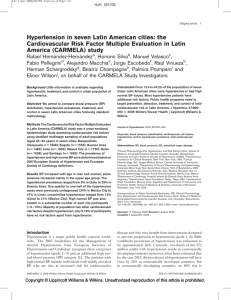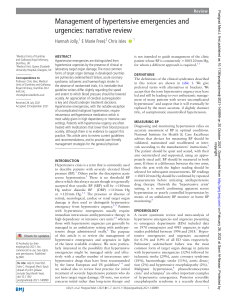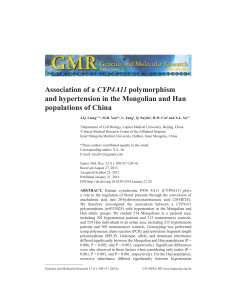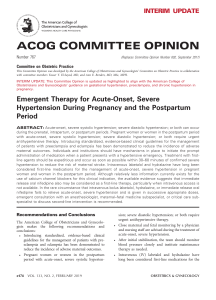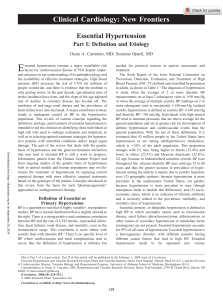Study on COgnition and Prognosis in the Elderly (SCOPE): Baseline
Anuncio
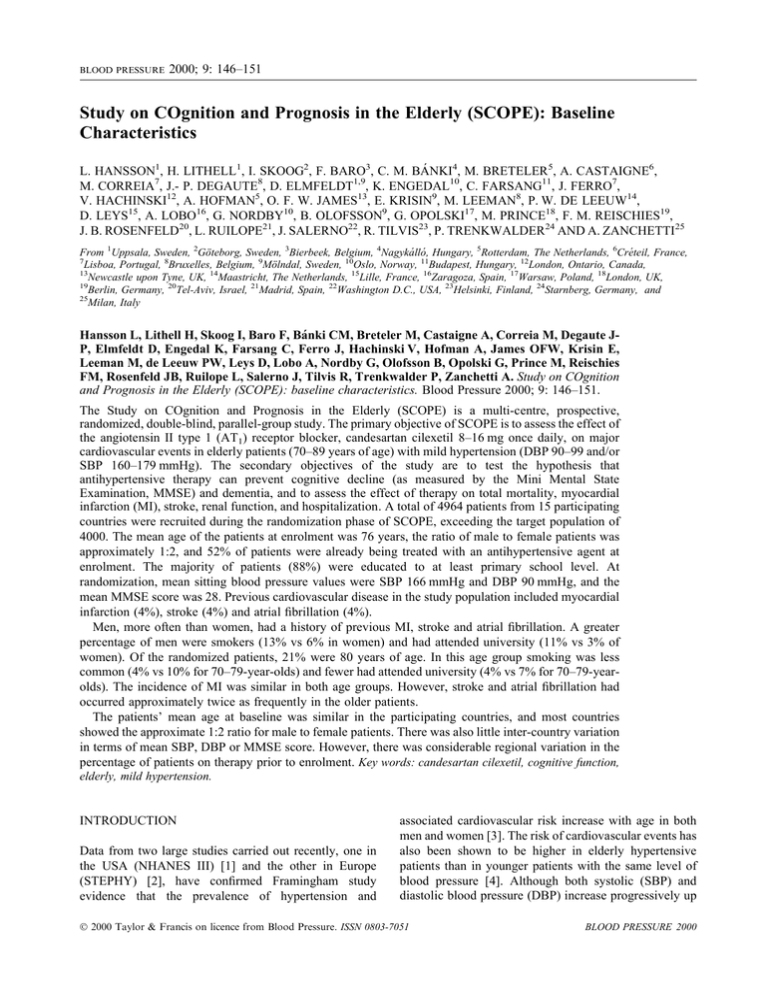
BLOOD PRESSURE 2000; 9: 146±151 Study on COgnition and Prognosis in the Elderly (SCOPE): Baseline Characteristics L. HANSSON1, H. LITHELL1, I. SKOOG2, F. BARO3, C. M. BÁNKI4, M. BRETELER5, A. CASTAIGNE6, M. CORREIA7, J.- P. DEGAUTE8, D. ELMFELDT1,9, K. ENGEDAL10, C. FARSANG11, J. FERRO7, V. HACHINSKI12, A. HOFMAN5, O. F. W. JAMES13, E. KRISIN9, M. LEEMAN8, P. W. DE LEEUW14, D. LEYS15, A. LOBO16, G. NORDBY10, B. OLOFSSON9, G. OPOLSKI17, M. PRINCE18, F. M. REISCHIES19, J. B. ROSENFELD20, L. RUILOPE21, J. SALERNO22, R. TILVIS23, P. TRENKWALDER24 AND A. ZANCHETTI25 From 1Uppsala, Sweden, 2Göteborg, Sweden, 3Bierbeek, Belgium, 4Nagykálló, Hungary, 5Rotterdam, The Netherlands, 6Créteil, France, 7 Lisboa, Portugal, 8Bruxelles, Belgium, 9Mölndal, Sweden, 10Oslo, Norway, 11Budapest, Hungary, 12London, Ontario, Canada, 13 Newcastle upon Tyne, UK, 14Maastricht, The Netherlands, 15Lille, France, 16Zaragoza, Spain, 17Warsaw, Poland, 18London, UK, 19 Berlin, Germany, 20Tel-Aviv, Israel, 21Madrid, Spain, 22Washington D.C., USA, 23Helsinki, Finland, 24Starnberg, Germany, and 25 Milan, Italy Hansson L, Lithell H, Skoog I, Baro F, Bánki CM, Breteler M, Castaigne A, Correia M, Degaute JP, Elmfeldt D, Engedal K, Farsang C, Ferro J, Hachinski V, Hofman A, James OFW, Krisin E, Leeman M, de Leeuw PW, Leys D, Lobo A, Nordby G, Olofsson B, Opolski G, Prince M, Reischies FM, Rosenfeld JB, Ruilope L, Salerno J, Tilvis R, Trenkwalder P, Zanchetti A. Study on COgnition and Prognosis in the Elderly (SCOPE): baseline characteristics. Blood Pressure 2000; 9: 146–151. The Study on COgnition and Prognosis in the Elderly (SCOPE) is a multi-centre, prospective, randomized, double-blind, parallel-group study. The primary objective of SCOPE is to assess the effect of the angiotensin II type 1 (AT1) receptor blocker, candesartan cilexetil 8–16 mg once daily, on major cardiovascular events in elderly patients (70–89 years of age) with mild hypertension (DBP 90–99 and/or SBP 160–179 mmHg). The secondary objectives of the study are to test the hypothesis that antihypertensive therapy can prevent cognitive decline (as measured by the Mini Mental State Examination, MMSE) and dementia, and to assess the effect of therapy on total mortality, myocardial infarction (MI), stroke, renal function, and hospitalization. A total of 4964 patients from 15 participating countries were recruited during the randomization phase of SCOPE, exceeding the target population of 4000. The mean age of the patients at enrolment was 76 years, the ratio of male to female patients was approximately 1:2, and 52% of patients were already being treated with an antihypertensive agent at enrolment. The majority of patients (88%) were educated to at least primary school level. At randomization, mean sitting blood pressure values were SBP 166 mmHg and DBP 90 mmHg, and the mean MMSE score was 28. Previous cardiovascular disease in the study population included myocardial infarction (4%), stroke (4%) and atrial fibrillation (4%). Men, more often than women, had a history of previous MI, stroke and atrial fibrillation. A greater percentage of men were smokers (13% vs 6% in women) and had attended university (11% vs 3% of women). Of the randomized patients, 21% were 80 years of age. In this age group smoking was less common (4% vs 10% for 70–79-year-olds) and fewer had attended university (4% vs 7% for 70–79-yearolds). The incidence of MI was similar in both age groups. However, stroke and atrial fibrillation had occurred approximately twice as frequently in the older patients. The patients’ mean age at baseline was similar in the participating countries, and most countries showed the approximate 1:2 ratio for male to female patients. There was also little inter-country variation in terms of mean SBP, DBP or MMSE score. However, there was considerable regional variation in the percentage of patients on therapy prior to enrolment. Key words: candesartan cilexetil, cognitive function, elderly, mild hypertension. INTRODUCTION Data from two large studies carried out recently, one in the USA (NHANES III) [1] and the other in Europe (STEPHY) [2], have confirmed Framingham study evidence that the prevalence of hypertension and associated cardiovascular risk increase with age in both men and women [3]. The risk of cardiovascular events has also been shown to be higher in elderly hypertensive patients than in younger patients with the same level of blood pressure [4]. Although both systolic (SBP) and diastolic blood pressure (DBP) increase progressively up 2000 Taylor & Francis on licence from Blood Pressure. ISSN 0803-7051 BLOOD PRESSURE 2000 SCOPE baseline characteristics 147 Table I. Comparison of events expected and prevented by antihypertensive treatment in elderly hypertensive patients and in middle-aged patients with mild hypertension [11]. The values shown are the number of events/1000 patients/5 years Middle-aged patients with mild hypertension Elderly patients with hypertension Events Expected Prevented Expected Prevented Cardiovascular deaths Strokes Coronary events 15 15 30 4–5 10 2–3 120 123 97 40 49 14 to approximately 60 years of age, DBP tends to decline thereafter [3]. As a result, isolated systolic hypertension (ISH; i.e. SBP > 140 mmHg/DBP < 90 mmHg) is the most prevalent form of hypertension in older patients, and SBP is a better predictor of cardiovascular events than DBP in the elderly [5]. It is only quite recently that the benefits of treating hypertension in the elderly have become apparent. Metaanalysis of nine randomized, controlled trials published over the period January 1980 to February 1992 involving 15 559 patients older than 59 years of age revealed a 36% reduction in stroke, a 25% decrease in coronary heart disease and a 12% reduction in all-cause mortality [6]. Several studies (STOP, SHEP, SYST-EUR and MRC elderly) have documented the benefits of antihypertensive therapy specifically among elderly patients with ISH, and showed a reduction in major cardiovascular events ranging from 17 to 40% [7–10]. Because the elderly hypertensive population may be expected to experience more cardiovascular events compared to a middle-aged hypertensive population, in absolute terms—that is, in terms of the number of events saved—antihypertensive treatment is 5–10 times more successful in elderly patients than in middle-aged patients with mild hypertension (Table I) [11]. Nevertheless, there remain a number of unanswered questions concerning the treatment of elderly patients with hypertension: (i) The term ‘elderly’ is generally used to indicate patients over the age of 60–65 years, but what are the benefits of antihypertensive therapy in patients over 80 years of age? (ii) Is the treatment of mild hypertension of benefit in the elderly? (iii) Since it has been shown that high blood pressure may be associated with subsequent development of dementia and cognitive decline in the elderly [12], can antihypertensive therapy reduce cognitive decline and the incidence of dementia? (iv) Is angiotensin II type 1 (AT1)-receptor blockade an effective therapeutic strategy for improving outcomes in an elderly population with mild hypertension? The Study on COgnition and Prognosis in the Elderly (SCOPE) has been initiated to address these questions. The study protocol has been described fully in a previous issue of this journal [13]. Briefly, SCOPE is a multicentre, prospective, randomized, double-blind, parallel-group study designed to compare the effects of the angiotensin II type 1 (AT1) receptor blocker, candesartan cilexetil 8– 16 mg once daily, versus placebo in elderly patients (70– 89 years of age) with mild hypertension (defined as sitting SBP 160–179 mmHg and/or DBP 90–99 mmHg), and a Mini-Mental State Examination (MMSE) score of 24, or higher. Patients who remain at SBP 160 mmHg and DBP 90 mmHg are recommended open-label additional antihypertensive medication, starting with HCTZ 12.5 mg. The primary objective of SCOPE is to assess the effect of candesartan cilexetil on major cardiovascular events. The secondary objectives of the study are to test the hypothesis that antihypertensive therapy can prevent cognitive decline (as measured by the MMSE) and dementia, and to assess the effect of therapy on total mortality, myocardial infarction, stroke, renal function and hospitalization. In addition, at least 1000 patients will be assessed for quality of life and health economics data. The study will also allow us to evaluate the possible influence on major cardiovascular events and cognitive function of a number of variables, including age, gender, antihypertensive treatment, previous myocardial infarction (MI) or stroke, diabetes mellitus, smoking, body mass index, hyperlipidaemia or treatment with lipid-lowering drugs, and level of education. PATIENT CHARACTERISTICS Overall Patients were considered eligible for enrolment in SCOPE if they fulfilled the inclusion and exclusion criteria, as described previously [13]. A total of 4964 patients from 15 participating countries were recruited during the randomization phase, from 24 March 1997 to 20 January 1999, exceeding the original target population of 4000 (Table II). The mean age of the patients at enrolment was 76 years (Table III), reflecting the predominance of patients in the younger, 70–79-year, age group (Fig. 1). BLOOD PRESSURE 2000 148 L. Hansson et al. Table II. Number of patients recruited to SCOPE per country (total n = 4964) Country Number Belgium Canada Finland France Germany Hungary Israel The Netherlands Norway Poland Portugal Spain Sweden UK USA 436 68 84 434 617 326 147 617 418 173 53 324 283 883 101 Fig. 1. Age distribution at baseline. Nevertheless, approximately one in five of the patients in the study (n = 1053) was aged 80 years and over at randomization. The ratio of male to female patients was approximately 1:2 (n = 1787 and n = 3177, respectively). At randomization, mean sitting blood pressure values were SBP 166 mmHg and DBP 90 mmHg, and the mean MMSE score was 28 (maximum score 30). The distribution of SBP, DBP and MMSE at randomization is shown in Figs 2 and 3. Just over half (52%) of all patients were receiving antihypertensive therapy at enrolment and nearly a quarter (22%) of the patient population was taking either an non-steroidal anti-inflammatory drug (NSAID) or ASA. A relatively small percentage of patients (9%) were being treated with lipid-lowering drugs, and a similar number were receiving psychopharmacological drugs (8%). The occurrence of previous cardiovascular disease in the study population was found to be relatively low, including myocardial infarction (4%), stroke (4%) and atrial fibrillation (4%; Table 3). The vast majority of patients had been educated to at least primary school level (Table 4). Gender-based differences in baseline characteristics. There were a number of notable differences in the baseline characteristics between the men and women randomized to the study. The men had a higher occurrence of previous MI (7.8% compared with 2.7% of women), atrial fibrillation (4.9% compared with 2.9% of women) and stroke (4.8% compared with 3.3% of women). A greater percentage of the men were smokers (13.2%) compared with the women (6.1%). Differences in the level of education between men and women were most notable at university level, with a considerably greater percentage of men who had attended university (11.1%) compared with women (3.1%). The proportion of men and women treated at enrolment was similar for most classes of medication with the exception of psychopharmacological drugs, which were being taken by 11.4% of women compared with 5.6% of men. Table III. Baseline patient characteristics (n = 4964) Age, years (mean) Male/female (%) Smoker (%) Mean sitting BP: SBP/DBP mmHg Mean MMSE score Treated at enrolment with: Antihypertensive agents (%) NSAID/ASA (%) Lipid-lowering drugs (%) Psychopharmacological drugs (%) Previous MI (%) Previous stroke (%) Atrial fibrillation (%) 76 36/64 9 166/90 28 52 22 9 8 4 4 4 BP, blood pressure; SBP, systolic blood pressure; DBP, diastolic blood pressure; MI, myocardial infarction. BLOOD PRESSURE 2000 Fig. 2. Distribution of systolic blood pressure (SBP) at baseline. SCOPE baseline characteristics Fig. 3. Distribution of diastolic blood pressure (DBP) at baseline. Age-based differences in baseline characteristics. The SCOPE study includes a large cohort of patients of 80 years of age and older, allowing a comparison of baseline characteristics with patients in the decade below them (those in the 70–79-year-old age group). There were slightly more than twice as many smokers amongst the 70–79-year-olds (9.8%), as amongst patients 80 years of age and older (4.3%). Also, more of the younger age cohort had attended university (6.5%), compared with the older group (3.8%). The incidence of MI was similar in both groups (4.4% in the 70–79-yearolds and 4.9% in patients of 80 years of age and older). However, stroke and atrial fibrillation had occurred more frequently in the older patients (5.9% compared with 3.3% for stroke and 5.9% compared with 3.0% for atrial fibrillation). Treatment with antihypertensive medication was similar between the age groups (52.8% for the 70–79year-olds and 52.6% for those of 80 years of age and older). The use of NSAIDs or ASA was also similar between the two groups (23.2% in the 70–79-year-olds and 23.9% in the older group). However, more patients in the younger group used lipid-lowering agents (10.1% compared with 6.2%), while more patients in the older group were taking psychopharmacological drugs compared with patients in younger group (12.4% compared with 8.5%). 149 Fig. 4. Distribution of Mini Mental State Examination (MMSE) score at baseline. from each participating country (range 74–77 years). Most countries also showed the approximate 1:2 ratio for male to female patients. There was little inter-country variation in terms of mean SBP (range 160–167 mmHg), DBP (range 86–92 mmHg) or MMSE score (range 28–29). However, considerable regional variations were seen for the percentage of patients on therapy prior to enrolment, including antihypertensive therapy (29–83%), NSAID/ASA (11–49%), lipid-lowering therapy (2–24%) and psychopharmacological therapy (1–26%). SAMPLE SIZE AND RISK PROFILE The original target study population was 4000, based on the incidence of clinical events in the STOP-Hypertension study [7]. This represents the calculated number of patients required in order to detect a 23% reduction in the yearly incidence of major cardiovascular events over a 2.5-year period, assuming a starting DBP of 95 mmHg. Although the actual mean baseline DBP in SCOPE is lower (90 mmHg), the study population is larger than expected (4964) and has been randomized over a longer period, thereby maintaining the power of the study. In the baseline data, information regarding the following risk factors (according to WHO/ISH guidelines) is available: BP, age and gender, smoking habit, scholesterol, diabetes mellitus, obesity, s-creatinine and previous cardiovascular diseases. Thus, all patients in the study have at least one risk factor (age >65 years), and Grade 1 or Grade 2 hypertension. Regional variations The mean age at baseline was similar within populations Table IV. Education level (n = 4964) Less than primary school (%) Primary school (%) Higher than primary school (%) University (%) 12 43 39 6 EVALUATION OF COGNITIVE FUNCTION The potential impact of antihypertensive therapy on cognitive function in SCOPE patients will be assessed using the MMSE, which has been demonstrated to be a sensitive, specific and predictive tool in measuring cognitive function and screening for dementia. The MMSE score is based on 20 clearly defined questions and tasks (which are documented in a manual developed BLOOD PRESSURE 2000 150 L. Hansson et al. for this study), giving a maximum potential score of 30. Based on a comparison of the MMSE and clinical diagnosis of dementia in 85–88 year old patients [15] and information from the literature [16], a decline of four points in MMSE score has been selected to indicate dementia. Suspected cases of dementia will be further evaluated by dementia specialists in the study endpoint committee. Patients who achieve the maximum MMSE score of 30 may have cognitive function well above the upper limit of the test, allowing them to suffer a decline in cognitive function of equivalent to the four MMSE points defined here, and yet remain above the maximum score level. However, more than 60% of the patients in the SCOPE study have an MMSE score of between 24 and 29. Hence, any decline in cognitive function in these patients will be within the detection range of the MMSE, suggesting that it will be possible in this study to evaluate the potential of antihypertensive therapy to prevent cognitive decline. THERAPEUTIC REGIMEN The SCOPE therapeutic regimen has been described previously and is summarized briefly here [13]. The study begins with an open, run-in period lasting 1–3 months, during which patients are assessed for eligibility and those who are already on antihypertensive therapy at enrolment are switched to hydrochlorothiazide (HCTZ) 12.5 mg once daily (o.d.). Subsequently, patients are randomized to receive either candesartan cilexetil 8 mg o.d. or matching placebo o.d. At subsequent study visits, if SBP remains >160 mmHg, or has decreased by <10 mmHg since the randomization visit, or DBP is >85 mmHg, study treatment is doubled to candesartan cilexetil 16 mg o.d. (two 8-mg tablets), or two placebo tablets. If SBP remains 160 mmHg, or DBP is 90 mmHg, despite treatment with two tablets, then the study protocol recommends the initiation of additional antihypertensive therapy, starting with HCTZ 12.5 mg. DISCUSSION Although the advantages of antihypertensive therapy in elderly patients with hypertension have been clearly demonstrated [6–11], there have been no specific studies to date to assess the benefits of treating those with only mildly elevated blood pressure (SBP 160–179 mmHg and/or DBP 90–99 mmHg), in terms of preventing cardiovascular events, stroke and the development of cognitive dysfunction. Currently, many such patients may go untreated, possibly resulting in earlier death, disability or hospitalization, with the associated personal, social and economic costs. The results of SCOPE will provide the necessary data to determine the value of antihypertensive therapy in this setting also in the very old patients. BLOOD PRESSURE 2000 The theory that elevated blood pressure may predispose patients to the development of dementia has been investigated in Sweden by Skoog et al. in a 15-year longitudinal study following up subjects who were nondemented at 70 years of age [13]. They found that patients who developed dementia after the age of 79 had significantly higher mean SBP and DBP at 70 years of age than those who did not develop dementia (178/ 101 mmHg vs 164/92 mmHg, respectively). The theory is supported by sub-study results from the SYST-EUR trial showing that antihypertensive therapy with nitrendipine (with or without enalapril and/or hydrochlorothiazide) in non-demented patients with isolated systolic hypertension over the age of 60 years reduced the incidence of dementia by 50% versus placebo over the 2-year followup period (7.7 versus 3.8 cases per 1000 patient years, p = 0.05) [17]. However, there were only 32 cases of dementia in this study. If it can be demonstrated that treatment of even mild hypertension in the elderly can reduce the incidence of dementia, this may have major consequences in terms of the socio-economic costs of the disease. Dementia undoubtedly takes a major toll on both the patients and their carers, who are frequently family and friends. Moreover, a significant positive correlation has been demonstrated between the evolution of dementia and healthcare costs, even in out-patients [18]. As the population of the western world continues to age, the prevalence of dementia and other diseases associated with old age will almost certainly increase [19]. Although studies analysing the economics of treating patients with Alzheimer’s disease have considered the costs of antidementia treatments rather than antihypertensive therapies, it has been suggested that large savings in the costs of caring for home-dwelling patients with Alzheimer’s disease may be achievable even with interventions that have only minor effects on patients’ cognitive status [20]. The AT1-receptor blocker, candesartan cilexetil, is a rational choice of antihypertensive agent for the treatment of mild hypertension in the elderly, having a wellestablished profile of dose-dependent efficacy [21] with placebo-like tolerability [22] and long-lasting antihypertensive effect from a once-daily dose [23]. Studies have already demonstrated that candesartan cilexetil 8–16 mg is effective and very well tolerated in elderly hypertensive patients [24]. Importantly, AT1-receptor blockers may help to maintain, or even improve cognitive function through specific mechanisms other than BP reduction, since angiotensin II has been shown to impair performance in learning and memory paradigms [25]. The potential benefits of AT1-receptor blockers in this setting have already been demonstrated in animal studies [26, 27]. SCOPE baseline characteristics CONCLUSIONS The baseline characteristics of the 4964 patients enrolled in SCOPE indicate that the target population of elderly patients with mild hypertension and with no current dementia has been achieved. The results will provide important data on the impact of antihypertensive therapy with candesartan cilexetil in this population, both in terms of cardiovascular events and cognitive function. REFERENCES 1. Burt VL, Culter JA, Higgins M, et al. Trends in the prevalence, awareness, treatment, and control of hypertension in the adult US population. Data from the health examination surveys, 1960 to 1991. Hypertension 1995; 26: 60–9. 2. Trenkwalder PR. STEPHY II (Starnberg Study on Epidemiology of Parkinsonism and Hypertension). Clin Cardiol 1998; 21: 129–30. 3. Kannel WB, Gordan T. Evaluation of cardiovascular risk in the elderly: the Framingham study. Bull N Y Acad Med 1978; 54: 573–91. 4. Vokonas PS, Kannel WB, Cupples LA. Epidemiology and risk of hypertension in the elderly: the Framingham study. J Hypertens 1988; 63 Suppl 6: S3–S9. 5. Kannel WB. Historic perspectives on the relative contributions of diastolic and systolic blood pressure elevation to cardiovascular risk profile. Am Heart J 1999; 138 (3 Pt 2): 205–10. 6. Insua JT, Sacks HS, Lau T-S, et al. Drug treatment of hypertension in the elderly: a meta-analysis. Ann Intern Med 1994; 121: 355–362. 7. Dahlöf B, Lindholm LH, Hansson L, Scherstén B, Ekbom T, Wester P-O. Mortality and morbidity in the Swedish Trial in Old Patients with Hypertension (STOP-Hypertension). Lancet 1991; 338: 1281–5. 8. SHEP Cooperative Research Group. Prevention of stroke by antihypertensive drug treatment in older persons with isolated systolic hypertension: final results of the Systolic Hypertension in the Elderly Program. JAMA 1991; 265: 3255–64. 9. Fagard RH, Staessen JA. Treatment of isolated systolic hypertension in the elderly: the Syst-Eur trial. Systolic Hypertension in Europe (Syst-Eur) Trial Investigators. Clin Exp Hypertens 1999; 21: 491–7. 10. MRC Working Party. Medical Research Council trial of treatment of hypertension in older adults: principal results. Br Med J 1992: 304–12. 11. Hansson L, Lindholm LH, Ekbom T, Dahlöf B, Lanke J, Scherstén B, Wester P-O, Hedner T, de Faire U, for the STOP-Hypertension-2 study group. Randomised trial of old and new antihypertensive drugs in elderly patients: cardiovascular mortality and morbidity the Swedish Trial in Old Patients with Hypertension-2 study. Lancet 1999; 354: 1751–6. 12. Holzgreve H, Middeke M. Treatment of hypertension in the elderly. Drugs 1993; 46 Suppl 2: 24–31. 13. Skoog I, Lernfelt B, Landahl S, et al. 15-year longitudinal study of blood pressure and dementia. Lancet 1996; 347: 1141–5. 14. Hansson L, Lithell H, Skoog I, et al. Study on COgnition 15. 16. 17. 18. 19. 20. 21. 22. 23. 24. 25. 26. 27. 151 and Prognosis in the Elderly (SCOPE). Blood Press 1999; 8: 177–83. Aevarsson O, Skoog I. A longitudinal population study on the Mini Mental State Examination in the very old. Relation to dementia and education. Dementia: in press. Tombaugh TN, McIntyre NJ. The Mini Mental State Examination: a comprehensive review. J Am Geriatr Soc 1992; 40: 922–935. Forette F, Seux ML, Staessen JA, et al. Prevention of dementia in randomised double-blind placebo-controlled Systolic Hypertension in Europe (Syst-Eur) trial. Lancet 1998; 352: 1347–51. Souetre EJ, Qing W, Vigoureux I, et al. Economic analysis of Alzheimer’s disease in outpatients: impact of symptom severity. Int J Psychogeriatr 1995; 7: 115–22. van den Bosch JH, Kardaun JW. Ziektelast door aandoeningen van het zenuwstelsel in Nederland. [Disease burden of nervous system disorders in The Netherlands.] Ned Tiidschr Geneeskd 1994; 138: 1219–24. Ernst RL, Hay JW, Fenn C, Tinklenberg J, Yesavage JA. Cognitive function and the costs of Alzheimer disease. An exploratory study. Arch Neurol 1997; 54: 687–93. Elmfeldt D, George M, Hübner R, Olofsson B. Candesartan cilexetil, a new generation angiotensin II antagonist, provides dose dependent antihypertensive effect. J Hum Hypertens 1997; 11 Suppl 2: S49–S53. Belcher G, Hubner R, George M, Elmfeldt D, Lunde H. Candesartan cilexetil: safety and tolerability in healthy volunteers and patients with hypertension. J Hum Hypertens 1997; 11 Suppl 2: S85–9. Lacourcière Y, Asmar R for the candesartan/losartan study investigators. A comparison of the efficacy and duration of action of candesartan cilexetil and losartan as assessed by clinic and ambulatory blood pressure after a missed dose, in truly hypertensive patients. A placebo-controlled, forced titration study. Am J Hypertens 1999; 12: 1181–87. McInnes GT, O’Kane KP, Jonker J, Roth J. The efficacy and tolerability of candesartan cilexetil in an elderly hypertensive population. J Hum Hypertens 1997; 11 Suppl 2: S75–80. Barnes JM, Barnes NM, Costall B, Horovitz ZP, Naylor RJ. Angiotensin II inhibits the release of [3H]acetylcholine from rat entorhinal cortex in vitro. Brain Res 1989; 492: 136–43. Barnes NM, Champaneria S, Costall B, Kelly ME, Murphy DA, Naylor RJ. Cognitive enhancing actions of DUP 753 detected in a mouse habituation paradigm. Neuroreport 1990; 1: 239–42. Barnes NM, Costall B, Kelly ME, Murphy DA, Naylor RJ. Cognitive enhancing actions of PD 123177 detected in a mouse habituation paradigm. Neuroreport 1991; 2: 351–3. Submitted February 7, 2000; accepted March 27, 2000 Address for correspondence: Lennart Hansson University of Uppsala Department of Public Health Clinical Hypertension Research PO Box 609 SE-75185 Uppsala Sweden BLOOD PRESSURE 2000 Copyright of Blood Pressure is the property of Taylor & Francis Ltd and its content may not be copied or emailed to multiple sites or posted to a listserv without the copyright holder's express written permission. However, users may print, download, or email articles for individual use.

